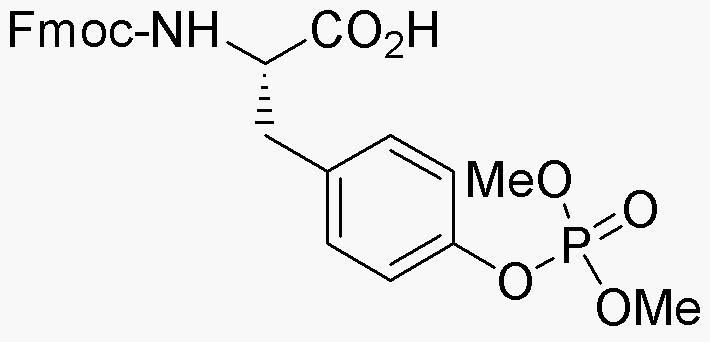Fmoc-O-dimethylphospho-L-tyrosine is widely utilized in research focused on:
- Peptide Synthesis: This compound serves as a crucial building block in the synthesis of phosphotyrosine-containing peptides, which are important for studying protein interactions and signaling pathways.
- Drug Development: It is used in the development of pharmaceuticals targeting tyrosine kinases, which play a significant role in cancer and other diseases, providing a pathway for innovative treatments.
- Bioconjugation: The chemical is employed in bioconjugation techniques, allowing researchers to attach biomolecules to surfaces or other molecules, enhancing the effectiveness of drug delivery systems.
- Analytical Chemistry: It aids in the development of analytical methods for detecting and quantifying phosphotyrosine in biological samples, facilitating research in cellular signaling and disease mechanisms.
- Biotechnology: This compound is utilized in various biotechnological applications, such as the design of biosensors that can detect specific proteins or enzymes, improving diagnostic capabilities.
General Information
Properties
Safety and Regulations
Applications
Fmoc-O-dimethylphospho-L-tyrosine is widely utilized in research focused on:
- Peptide Synthesis: This compound serves as a crucial building block in the synthesis of phosphotyrosine-containing peptides, which are important for studying protein interactions and signaling pathways.
- Drug Development: It is used in the development of pharmaceuticals targeting tyrosine kinases, which play a significant role in cancer and other diseases, providing a pathway for innovative treatments.
- Bioconjugation: The chemical is employed in bioconjugation techniques, allowing researchers to attach biomolecules to surfaces or other molecules, enhancing the effectiveness of drug delivery systems.
- Analytical Chemistry: It aids in the development of analytical methods for detecting and quantifying phosphotyrosine in biological samples, facilitating research in cellular signaling and disease mechanisms.
- Biotechnology: This compound is utilized in various biotechnological applications, such as the design of biosensors that can detect specific proteins or enzymes, improving diagnostic capabilities.
Documents
Safety Data Sheets (SDS)
The SDS provides comprehensive safety information on handling, storage, and disposal of the product.
Product Specification (PS)
The PS provides a comprehensive breakdown of the product’s properties, including chemical composition, physical state, purity, and storage requirements. It also details acceptable quality ranges and the product's intended applications.
Certificates of Analysis (COA)
Search for Certificates of Analysis (COA) by entering the products Lot Number. Lot and Batch Numbers can be found on a product’s label following the words ‘Lot’ or ‘Batch’.
Numéro de catalogue
Numéro de lot/série
Certificates Of Origin (COO)
This COO confirms the country where the product was manufactured, and also details the materials and components used in it and whether it is derived from natural, synthetic, or other specific sources. This certificate may be required for customs, trade, and regulatory compliance.
Numéro de catalogue
Numéro de lot/série
Safety Data Sheets (SDS)
The SDS provides comprehensive safety information on handling, storage, and disposal of the product.
DownloadProduct Specification (PS)
The PS provides a comprehensive breakdown of the product’s properties, including chemical composition, physical state, purity, and storage requirements. It also details acceptable quality ranges and the product's intended applications.
DownloadCertificates of Analysis (COA)
Search for Certificates of Analysis (COA) by entering the products Lot Number. Lot and Batch Numbers can be found on a product’s label following the words ‘Lot’ or ‘Batch’.
Numéro de catalogue
Numéro de lot/série
Certificates Of Origin (COO)
This COO confirms the country where the product was manufactured, and also details the materials and components used in it and whether it is derived from natural, synthetic, or other specific sources. This certificate may be required for customs, trade, and regulatory compliance.


